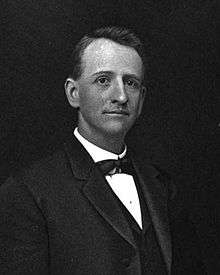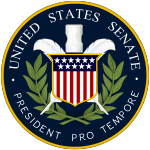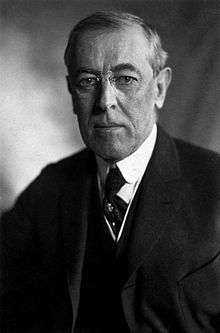Carter Glass
| Carter Glass | |
|---|---|
 | |
| 47th United States Secretary of the Treasury | |
|
In office December 16, 1918 – February 1, 1920 | |
| President | Woodrow Wilson |
| Preceded by | William G. McAdoo |
| Succeeded by | David F. Houston |
| United States Senator from Virginia | |
|
In office February 20, 1920 – May 28, 1946 | |
| Preceded by | Thomas S. Martin |
| Succeeded by | Thomas G. Burch |
| President pro tempore of the United States Senate | |
|
In office July 11, 1941 – January 2, 1945 | |
| Preceded by | Pat Harrison |
| Succeeded by | Kenneth McKellar |
| Chairman of the Senate Appropriations Committee | |
|
In office 1933–1946 | |
| Preceded by | Frederick Hale |
| Succeeded by | Kenneth D. McKellar |
| Member of the U.S. House of Representatives from Virginia's 6th district | |
|
In office November 4, 1902 – December 16, 1918 | |
| Preceded by | Peter J. Otey |
| Succeeded by | James P. Woods |
| Chairman of the House Committee on Banking and Currency | |
|
In office 1913–1918 | |
| Preceded by | Arsène Pujo |
| Succeeded by | Michael Francis Phelan |
| Member of the Virginia Senate from the 20th district | |
|
In office December 6, 1899 – November 4, 1902 | |
| Preceded by | Adam Clement |
| Succeeded by | Don P. Halsey |
| Personal details | |
| Born |
January 4, 1858 Lynchburg, Virginia, U.S. |
| Died |
May 28, 1946 (aged 88) Washington, D.C., U.S. |
| Political party | Democratic |
| Profession | Politician, editor |
| Religion | Methodist |
| Signature |
|
Carter Glass (January 4, 1858 – May 28, 1946) was a newspaper publisher and Progressive politician from Lynchburg, Virginia. He served many years in the United States Congress as a member of the Democratic Party. As House co-sponsor, he played a central role in the development of the 1913 Glass–Owen Act that created the Federal Reserve System. Glass subsequently served as the U.S. Secretary of the Treasury under President Woodrow Wilson. Later elected to the Senate, he became widely known as co-sponsor of the Glass–Steagall Act of 1933, which enforced the separation of investment banking and commercial banking, and established the Federal Deposit Insurance Corporation (FDIC).
Youth and education
Carter Glass was born in Lynchburg, Virginia, the fifth of twelve children. His mother, Augusta Elizabeth (née Christian) Glass, died in 1860, when he was only 2 years old. His sister Nannie, ten years older, became his surrogate mother. His father, Robert Henry Glass, owned the Lynchburg Daily Republican newspaper, and was also Lynchburg's postmaster.
The American Civil War (1861–1865) broke out when Glass was 3 years old. His father initially worked to try to help keep Virginia from seceding. However, after the state did so, Robert Henry Glass served, initially, in the Virginia forces in 1861, and then with the Confederate Army, where he became a major on the staff of Brigadier General John B. Floyd, a former Governor of Virginia. Although Glass's father survived the Civil War, 18 of his mother's relatives did not.
In poverty-stricken Virginia during the post-War period, the young Glass received only a basic education, although his father kept an extensive library. He became an apprentice printer to his father when he was 13 years old, and continued his education through reading. Glass read Plato, Edmund Burke and William Shakespeare, among others that stimulated an intellectual interest which became lifelong.
Early career
When Glass was 19 years old, he moved with his father to Petersburg. However, when young Glass could not find a job as a newspaper reporter in Petersburg, he returned to Lynchburg, and went to work for former Confederate General (and future U.S. Senator) William Mahone's Atlantic, Mississippi and Ohio Railroad (AM&O), which was in receivership from 1877 to 1880. Glass was a clerk in the auditor's office at the railroad's headquarters. Several years later, under new owners and with headquarters relocated to Roanoke, the railroad became the Norfolk and Western (N&W). However, by then Glass had found the newspaper job he had initially wanted. His formative years as Virginia struggled to resolve a large pre-War debt (Mahone being a leading figure in the Readjuster Party) and dealing with boom-and-bust economic cycles (some linked with stock speculation), helped mold Glass' conservative fiscal thinking, much as it did many other Virginia's political leaders of his era.

At the age of 22, Glass finally became a reporter, a job he had long sought, for the Lynchburg News. He rose to become the morning newspaper's editor by 1887. The following year, the publisher retired and offered Glass an option to purchase the business. Desperate to find financial backing, Glass received the unexpected assistance from a relative who loaned him enough for a $100 down payment on the $13,000 deal.[1] Free to write and publish whatever he wished, Glass wrote bold editorials and encouraged tougher reporting in the morning paper, which increased sales. Soon, Glass was able to acquire the afternoon Daily Advance, then to buy out the competing Daily Republican. Thus he became Lynchburg's sole newspaper publisher; the modern-day Lynchburg News and Advance is the successor publication to his newspapers.
Entry into politics
As a prominent and respected newspaper editor, Glass often supported candidates who ran against Virginia's Democrats of the post-Reconstruction period, who he felt were promoting bad fiscal policy. In 1896, the same year his father died, Glass attended the Democratic National Convention as a delegate, and heard William Jennings Bryan speak.[2] Glass was elected to the Senate of Virginia in 1899, and was a delegate to the Virginia constitutional convention of 1901–1902. He was one of the most influential members of the convention, which instituted measures associated with the Progressive movement, such as the establishment of the State Corporation Commission to regulate railroads and other corporations, replacing the former Virginia Board of Public Works.
The 1902 Constitution instituted a poll tax and required bulk payment after a voter missed elections, making voting a luxury that poor people, which included many African-Americans, could not often afford. The Constitution also required that voters pass a literacy test, a poll test on the Virginia Constitution, with their performance graded by the registrar. When questioned as to whether these measures were potentially discriminatory, Glass exclaimed, "Discrimination! Why that is exactly what we propose. To remove every negro voter who can be gotten rid of, legally, without materially impairing the numerical strength of the white electorate."[3] Indeed, the number of African-Americans qualified to vote dropped from 147,000 to 21,000 immediately.[4]
Congress, Secretary of the Treasury
Glass was elected to United States House of Representatives as a Democrat in 1902, to fill a vacancy. In 1913, he became Chairman of the House Committee on Banking and Currency, where he worked with President Woodrow Wilson, a fellow Virginian, to pass the Glass-Owen Federal Reserve Act. In 1918, Wilson appointed him Secretary of the Treasury, succeeding William Gibbs McAdoo. His signature as Secretary of the Treasury can be found on series 1914 Federal Reserve Notes, issued while he was in office. At the 1920 Democratic National Convention Glass was nominated for President as a favorite son candidate from Virginia.
Glass served at the Treasury until 1920, when he was appointed to the United States Senate to fill the vacancy caused by the death of Virginia's senior senator, Thomas Staples Martin. Martin had been widely regarded as the head of Virginia's Democratic Party, a role filled during the 1920s by Harry Flood Byrd of Winchester, another Virginia newspaperman who shared many of Glass's political views and who headed the political machine of Conservative Democrats known as the Byrd Organization, which dominated Virginia's politics until the 1960s. In 1933, Byrd became Virginia's junior Senator, joining Glass in the Senate after former Governor and then-senior U.S. Senator Claude A. Swanson was appointed as U.S. Secretary of the Navy by President Franklin Roosevelt. Both Glass and Byrd were opposed to Roosevelt's New Deal policies. Each was a strong supporter of fiscal conservatism and state's rights. Glass and Byrd invoked senatorial courtesy to defeat Roosevelt's nomination of Floyd H. Roberts to a federal judgeship, as part of a broader conflict over control of federal patronage in Virginia.
Glass served in the U.S. Senate for the remainder of his life, turning down the offer of a new appointment as Secretary of the Treasury from President Roosevelt in 1933. When the Democrats regained control of the Senate in 1933, Glass became Chairman of the Appropriations Committee. He was President pro tempore from 1941 to 1945. As a Senator, Glass's most notable achievement was passage of the Glass–Steagall Act, which separated the activities of banks and securities brokers and created the Federal Deposit Insurance Corporation.
Electoral history
- 1902; Glass was elected to the U.S. House of Representatives with 79.41% of the vote, defeating Republican Aaron Graham, Independent Republican James S. Cowden, and Socialist Labor H.D. McTier.
- 1904; Glass was re-elected with 69.07% of the vote, defeating Republican Samuel H. Hoge and Socialist Elory R. Spencer.
- 1906; Glass was re-elected unopposed.
- 1908; Glass was re-elected with 65.92% of the vote, defeating Republicans M. Hartman and John M. Parsons and Independent Jacob Harvey.
- 1910; Glass was re-elected with 87.64% of the vote, defeating Republican William F. Allison.
- 1912; Glass was re-elected with 72.84% of the vote, defeating Populist James S. Browning and Independents Adon A. Yoder and Jacob Harvey.
- 1914; Glass was re-elected with 90.72% of the vote, defeating Socialist B.F. Ginther.
- 1916; Glass was re-elected unopposed.
- 1918; Glass was re-elected unopposed.
Family, decline, death
When he was twenty-eight, Glass had married Aurelia McDearmon Caldwell, a school teacher. They had four children. She died of a heart ailment in 1937.[5] Glass remarried in 1940 at the age of 82. His second wife, Mary Scott, was his constant companion as his health began to fail over the next few years. They lived at the Mayflower Hotel Apartments in Washington, D.C. Starting in 1942, Glass began suffering from various age-related illnesses and could not attend Senate meetings after that time. However, he refused to resign from the Senate, despite many requests that he do so and even kept his committee chairmanship. Many visitors were also kept away from him by his wife.[6]
A confidential 1943 analysis of the Senate Foreign Relations Committee by Isaiah Berlin for the British Foreign Office stated that Glass[7]
is very old and frail and something of a legend in the South. The fruit-growing interests of his State make him an opponent of the reciprocal trade pacts, but on all other questions he has loyally supported the President's anti-Isolationist policy. He cannot have many years of active service before him.
Glass died of congestive heart failure in Washington, D.C., on May 28, 1946. He is interred at Spring Hill Cemetery in Lynchburg. His fellow sponsor of the Glass-Owen Act, Senator Robert Latham Owen, lies nearby.
Legacy
"Montview", also known as the "Carter Glass Mansion", was built in 1923 on his farm outside the then boundaries of Lynchburg in Campbell County. It is listed on the National Register of Historic Places and now serves as a museum on the grounds of Liberty University. It lies within the expanded city limits of Lynchburg. The front lawn of "Montview" is the burial site of Dr. Jerry Falwell, founder of Liberty University.[8]
The Virginia Department of Transportation's Carter Glass Memorial Bridge was named in his honor in 1949. It carries the Lynchburg bypass of U.S. Route 29, the major north-south highway in the region, across the James River between Lynchburg and Amherst County.[9]
A chair in the Department of Government was created in Glass's honor at Sweet Briar College. It has been held by notable faculty that have included Dr. Barbara A. Perry.
Glass is one of the few Americans who appeared on a coin during their lifetime. As a very prominent citizen of the city, the 1936 Lynchburg Sesquicentennial commemorative half dollar shows his image and name on the obverse. Only 20,000 of these souvenirs were minted as it was not intended for regular circulation.[10]
References
- ↑ Current Biography 1941, pp.321–23
- ↑ "Carter Glass – The Region – Publications & Papers | Federal Reserve Bank of Minneapolis". Minneapolisfed.org. Retrieved 2010-10-17.
- ↑ Damon W. Root, When bigots become reformers: the Progressive Era's shameful record on race, May 2006
- ↑ Wilkinson, III, J. Harvie (1968). Harry Byrd and the Changing Face of Virginia Politics, 1945–66. Charlottesville: University Press of Virginia. p. 38.
- ↑ "Milestones, Jun. 14, 1937". Time. 1937-06-14. Retrieved 2010-10-17.
- ↑ "Elder Statesman". Time. 1945-02-19. Retrieved 2010-10-17.
- ↑ Hachey, Thomas E. (Winter 1973–1974). "American Profiles on Capitol Hill: A Confidential Study for the British Foreign Office in 1943" (PDF). Wisconsin Magazine of History. 57 (2): 141–153. JSTOR 4634869. Archived from the original (PDF) on 2013-10-21.
- ↑ "National Register of Historical Places – VIRGINIA (VA), Lynchburg County". Nationalregisterofhistoricplaces.com. Retrieved 2010-10-17.
- ↑ "Designated Interstate and Primary Route Numbers, Named Highways, Named Bridges and Designated Virginia Byways" (PDF). Virginia Department of Transportation. Archived from the original (PDF) on July 1, 2015. Retrieved October 17, 2010.
- ↑ Silver Commemoratives 1936 LYNCHBURG 50C MS
Further reading
- Biographical Dictionary of the United States Secretaries of the Treasury, 1789–1995 By Bernard S. Katz, C. Daniel Vencill, Greenwood Press
- Carter Glass: A Biography By Rixey Smith, Norman Beasley (1939) republished by Ayer Company Publishers, ISBN 0-8369-5446-7
External links
| Wikimedia Commons has media related to Carter Glass. |
- United States Congress. "Carter Glass (id: G000232)". Biographical Directory of the United States Congress.
- Statements and Speeches of Carter Glass
| United States House of Representatives | ||
|---|---|---|
| Preceded by Peter J. Otey |
Member of the U.S. House of Representatives from Virginia's 6th congressional district November 4, 1902 – December 16, 1918 |
Succeeded by James P. Woods |
| Political offices | ||
| Preceded by William G. McAdoo |
U.S. Secretary of the Treasury Served under: Woodrow Wilson December 16, 1918 – February 1, 1920 |
Succeeded by David F. Houston |
| Preceded by B. Patton Harrison |
President pro tempore of the United States Senate July 11, 1941 – January 2, 1945 |
Succeeded by Kenneth D. McKellar |
| United States Senate | ||
| Preceded by Thomas S. Martin |
U.S. Senator (Class 2) from Virginia February 2, 1920 – May 28, 1946 Served alongside: Claude A. Swanson, Harry F. Byrd |
Succeeded by Thomas G. Burch |
| Awards and achievements | ||
| Preceded by Alfred von Tirpitz |
Cover of Time Magazine June 9, 1924 |
Succeeded by Pope Pius XI |




